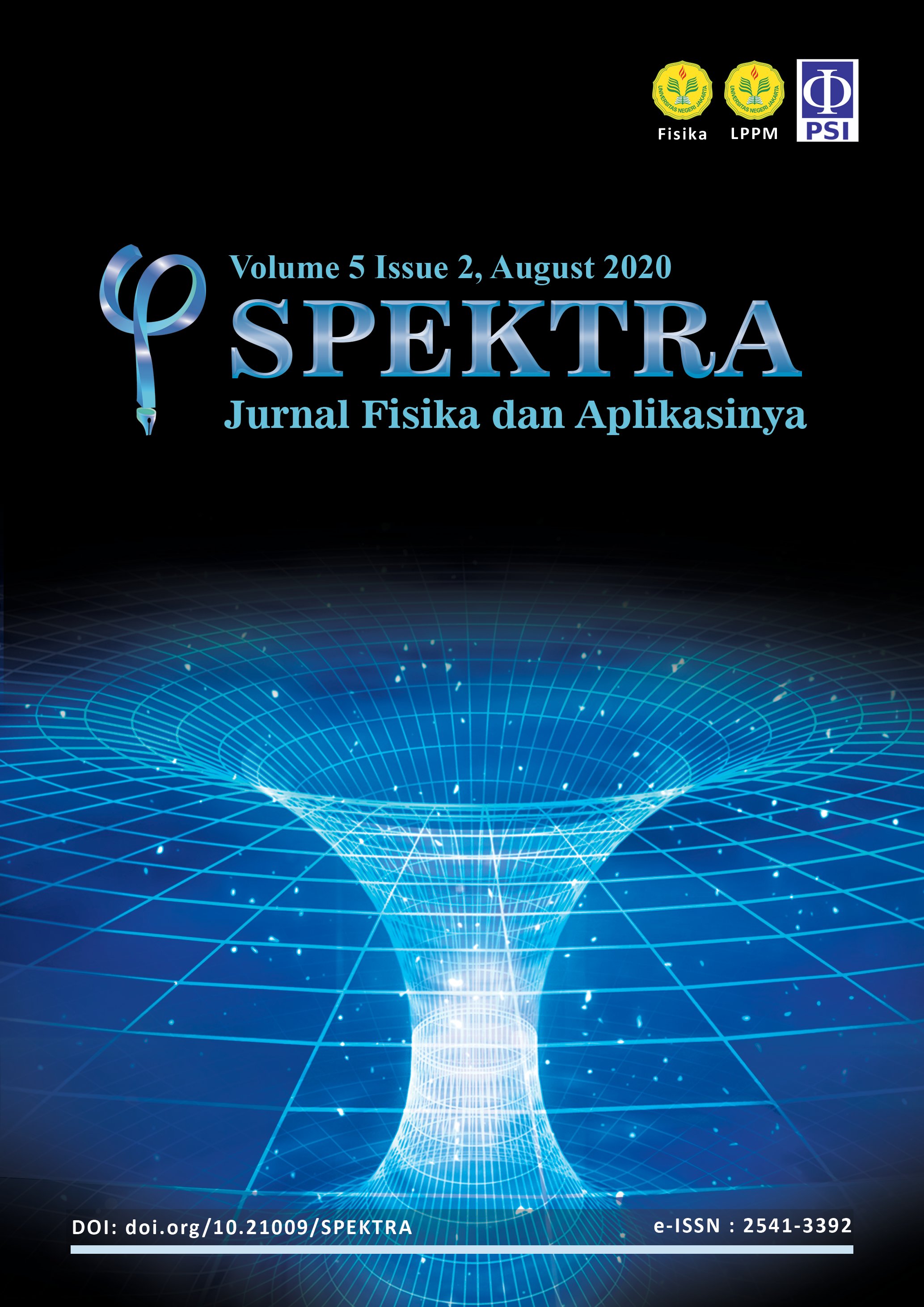THE EFFECT OF COBALT CONTENT ON MAGNETIC PROPERTIES OF CoFe ALLOYS
DOI:
https://doi.org/10.21009/SPEKTRA.052.01Keywords:
CoFe alloy, Currie temperature, hysteresis curve, coercivity fieldAbstract
Hard Disk Drive (HDD) as a data storage device when operated with high temperatures (around 66oC), its function will be constrained. The CoFe alloys have a large coercivity field and can be patterned in very small sizes that are suitable for HDD devices. In this study, Co1-x Fex cube alloy was used (x = 0.25; 0.30; 0.50; 0.75). Samples were treated with temperature changes to get the Curie temperature. The coercivity field value is obtained by giving the external field and temperature below Curie temperature and also above Curie temperature to the samples. The VAMPIRE software is a micromagnetic simulation program based on atomistic models. The results showed that Curie’s temperature decreased when Co content increased. The composition of Co0.25 Fe0.75 has the highest Curie temperature that is equal to 1075 K. The temperature Curie is not affected by the size of the cube. When the sample is given a temperature rise below the Curie temperature, the value of the coercivity field decreases. The value of the coercivity field is very difficult to determine when the temperature used is above the Curie temperature. The percentage of composition does not affect the coercivity field value. Therefore, cube-shaped CoFe material is very suitable for use as a material data storage device operated at temperatures below the Curie.
References
[2] M. Pauzan et al., “Pengaruh ukuran butir dan struktur kristal terhadap sifat kemagnetan pada nanopartikel magnetit (Fe3O4),” Prosiding Pertemuan Ilmiah XXVII HFI Jateng & DIY, 2013.
[3] B. E. Purnama et al., “Rancang Bangun Alat Kontrol Otomatis Pendingin Komputer Berbasis Mikrokontroler ATMEGA8L,” IJNS-Indonesian Journal on Networking and Security, 2013, vol. 2.
[4] T. D. Sugiarto, R. F. Iskandar and I.P. Handayani, “Simulation of Temperature Distribution in Horizontal Fin Heat Sink CPU Processor Using Comsol Multiphysics and Proportional Control,” Journal of Measurements, Electronics, Communications, and Systems, 2015, vol. 1.
[5] N. Aiga, “Simulasi Mikromagnetik Sifat-Sifat Material Co0.8Ni0.2 Random Alloy Berbagai Variasi Ukuran Partikel,” Repository Universitas Jember, 2018.
[6] W. Nursiyanto and L. Rohman, “Analisis Diameter Kritis dan Suhu Curie Bahan Parmalloy FeCoB Berbentuk Bola-Nano serta Pengaruh Temperatur (Heat Assisted) dengan Menggunakan Program Simulasi Mikromagnetik NMAG dan Vampire,” Spektra: Jurnal Fisika dan Aplikasinya, 2017.
[7] M. D. C. Agguire et al., “Co1.00-x Fex magnetic thick films prepared by electrodeposition,” Journal of Alloys and Compounds, 2015.
[8] I. Wahyudi, “Suseptibilitas Magnetik dan Temperatur Curie Material Alloy Feromagnetik Co1-xNix Model Nanotube dan Nanosphere,” Repository Universitas Jember, 2018.
[9] Evans, F.L dan Biternas, A., “Vampire User Manual : Software Version 4.0.,”Heslington: The University of York, 2014. R. F. L. Evans and A. Biternas, “Vampire User Manual: Software Version 4.0,” New York: The University of New York, 2014.
[10] P. Ho et al., “Atomistic Modeling of the Interlayer Coupling Behavior in Perpendicularly Magnetized L10-FePt/Ag/L10-FePt Pseudo Spin Valves,” IEEE transactions on magnetics, 2011.
[11] R. F. L. Evans et al., “Atomistic spin model simulations of magnetic nanomaterials,” J. Phys.: Condens. Matter, 2014, vol. 26.
[12] A. T. Widodo, “Studi Mikromagnetik Dinamika Struktur Domain Pada Material Feromagnetik Py, Ni, Fe Dan Co Model Nanosphere,” Depok: Universitas Indonesia, 2013.
Downloads
Published
How to Cite
Issue
Section
License
SPEKTRA: Jurnal Fisika dan Aplikasinya allow the author(s) to hold the copyright without restrictions and allow the author(s) to retain publishing rights without restrictions. SPEKTRA: Jurnal Fisika dan Aplikasinya CC-BY or an equivalent license as the optimal license for the publication, distribution, use, and reuse of scholarly work. In developing strategy and setting priorities, SPEKTRA: Jurnal Fisika dan Aplikasinya recognize that free access is better than priced access, libre access is better than free access, and libre under CC-BY or the equivalent is better than libre under more restrictive open licenses. We should achieve what we can when we can. We should not delay achieving free in order to achieve libre, and we should not stop with free when we can achieve libre.
 SPEKTRA: Jurnal Fisika dan Aplikasinya is licensed under a Creative Commons Attribution 4.0 International License.
SPEKTRA: Jurnal Fisika dan Aplikasinya is licensed under a Creative Commons Attribution 4.0 International License.
You are free to:
Share - copy and redistribute the material in any medium or format
Adapt - remix, transform, and build upon the material for any purpose, even commercially.
The licensor cannot revoke these freedoms as long as you follow the license terms.

 E-ISSN 2541-3392
E-ISSN 2541-3392  Focus & Scope
Focus & Scope  Editorial Team
Editorial Team  Reviewer Team
Reviewer Team  Author Guidelines
Author Guidelines  Article Template
Article Template  Author Fee
Author Fee  Publication Ethics
Publication Ethics  Plagiarism Policy
Plagiarism Policy  Open Access Policy
Open Access Policy  Peer Review Process
Peer Review Process  Retraction & Correction
Retraction & Correction  Licensing & Copyright
Licensing & Copyright  Archiving & Repository
Archiving & Repository  Contact
Contact  Mendeley
Mendeley 

